Strategic Cost Management: Techniques, Trends, and Contemporary Issues
VerifiedAdded on 2020/03/23
|15
|3792
|68
Report
AI Summary
This report provides a comprehensive overview of Strategic Cost Management (SCM), examining its role in the contemporary business environment. It delves into the evolution of SCM as a critical survival skill in the face of globalization, disruptive technologies, and changing market dynamics. The report offers a literature review, exploring SCM as a strategic approach and detailing various techniques such as Activity-Based Costing (ABC), Target Costing (TC), Total Quality Management (TQM), Benchmarking, Business Process Reengineering (BPR), JIT Inventory Control System, and the Balanced Scorecard. It analyzes the identification of trends and contemporary issues businesses face, emphasizing the shift from traditional cost management to a strategic approach. The report further discusses the success of SCM and its techniques, including TQM, Benchmarking, and BPR, highlighting their application in addressing the challenges of the modern business landscape. The report underscores the importance of SCM in enhancing a firm's strategic position and reducing costs to maintain a competitive edge.
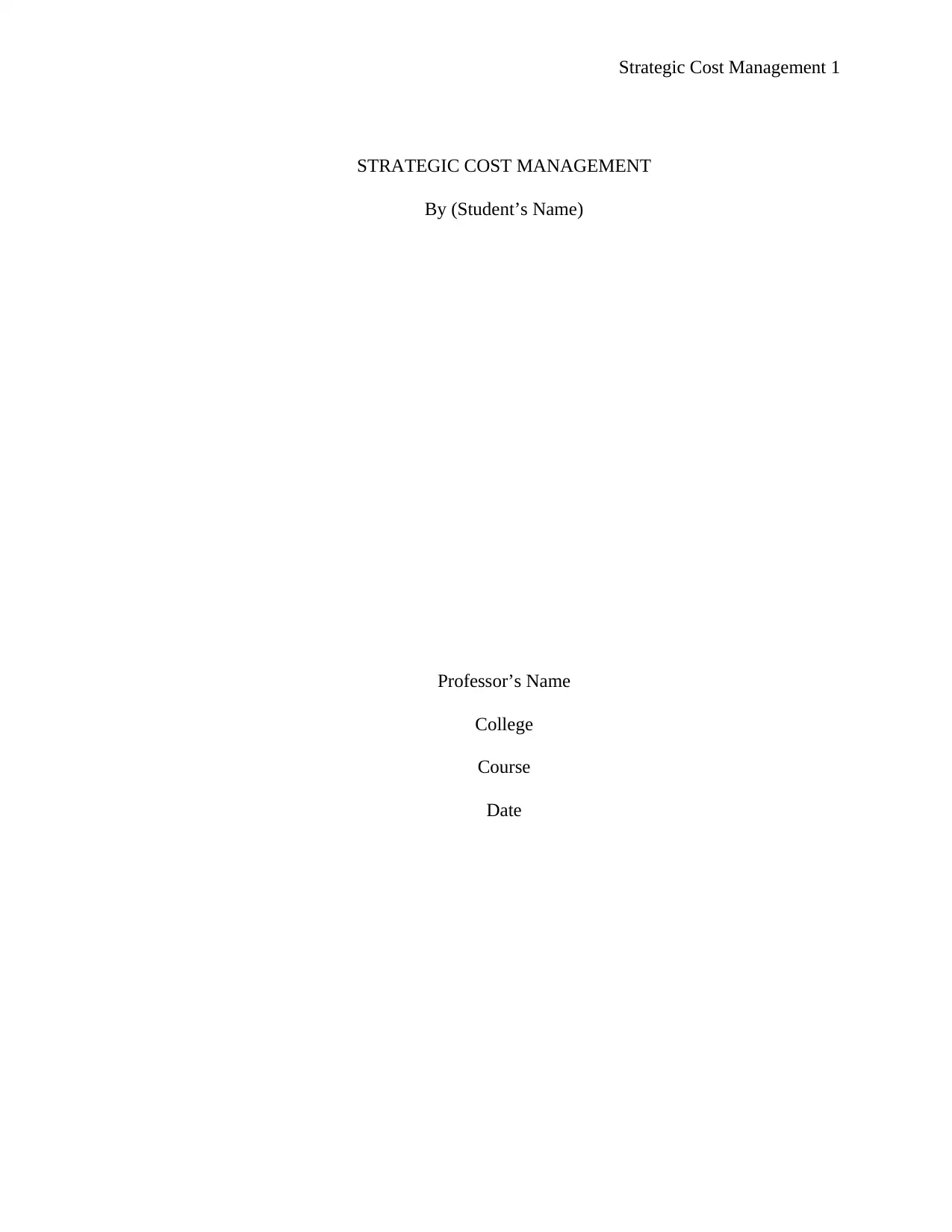
Strategic Cost Management 1
STRATEGIC COST MANAGEMENT
By (Student’s Name)
Professor’s Name
College
Course
Date
STRATEGIC COST MANAGEMENT
By (Student’s Name)
Professor’s Name
College
Course
Date
Paraphrase This Document
Need a fresh take? Get an instant paraphrase of this document with our AI Paraphraser
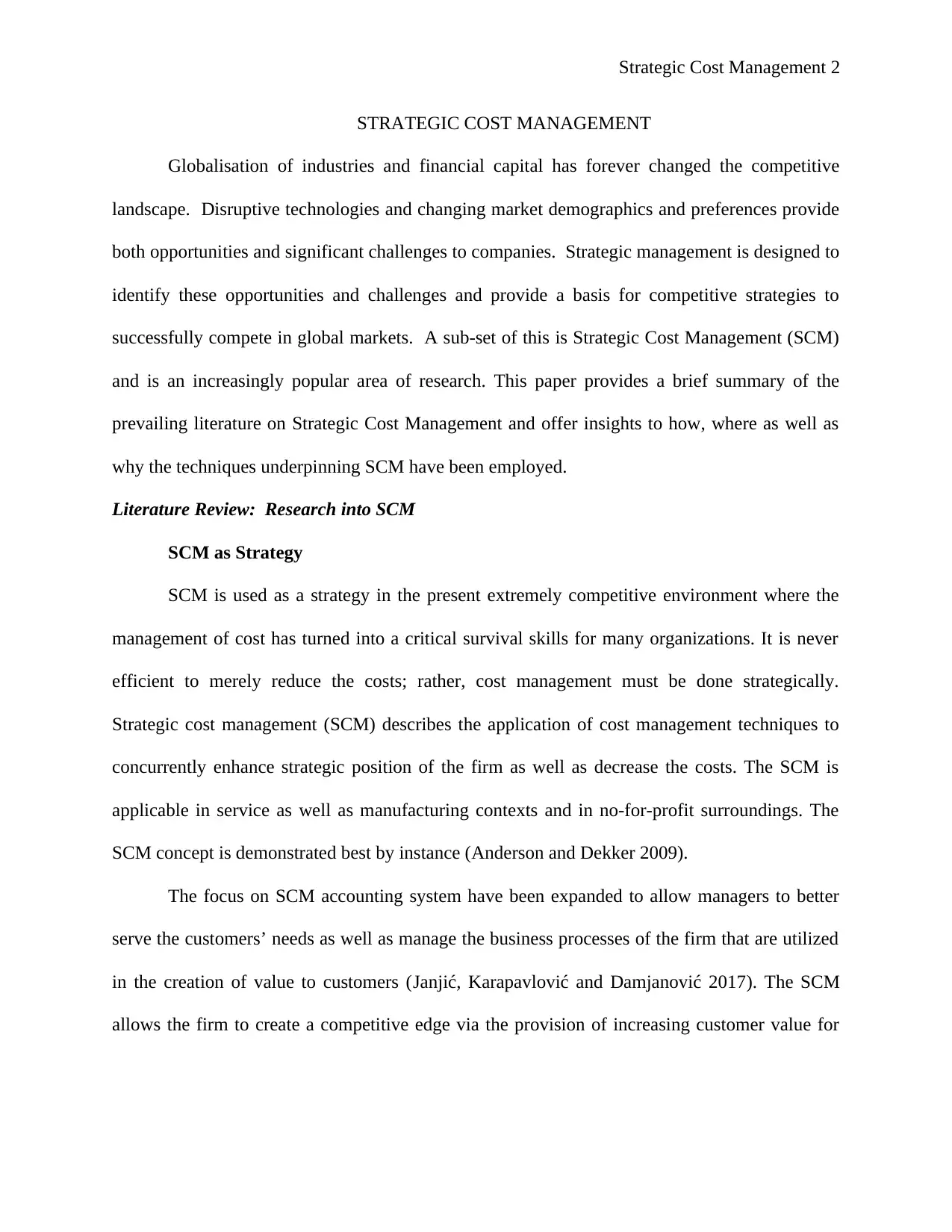
Strategic Cost Management 2
STRATEGIC COST MANAGEMENT
Globalisation of industries and financial capital has forever changed the competitive
landscape. Disruptive technologies and changing market demographics and preferences provide
both opportunities and significant challenges to companies. Strategic management is designed to
identify these opportunities and challenges and provide a basis for competitive strategies to
successfully compete in global markets. A sub-set of this is Strategic Cost Management (SCM)
and is an increasingly popular area of research. This paper provides a brief summary of the
prevailing literature on Strategic Cost Management and offer insights to how, where as well as
why the techniques underpinning SCM have been employed.
Literature Review: Research into SCM
SCM as Strategy
SCM is used as a strategy in the present extremely competitive environment where the
management of cost has turned into a critical survival skills for many organizations. It is never
efficient to merely reduce the costs; rather, cost management must be done strategically.
Strategic cost management (SCM) describes the application of cost management techniques to
concurrently enhance strategic position of the firm as well as decrease the costs. The SCM is
applicable in service as well as manufacturing contexts and in no-for-profit surroundings. The
SCM concept is demonstrated best by instance (Anderson and Dekker 2009).
The focus on SCM accounting system have been expanded to allow managers to better
serve the customers’ needs as well as manage the business processes of the firm that are utilized
in the creation of value to customers (Janjić, Karapavlović and Damjanović 2017). The SCM
allows the firm to create a competitive edge via the provision of increasing customer value for
STRATEGIC COST MANAGEMENT
Globalisation of industries and financial capital has forever changed the competitive
landscape. Disruptive technologies and changing market demographics and preferences provide
both opportunities and significant challenges to companies. Strategic management is designed to
identify these opportunities and challenges and provide a basis for competitive strategies to
successfully compete in global markets. A sub-set of this is Strategic Cost Management (SCM)
and is an increasingly popular area of research. This paper provides a brief summary of the
prevailing literature on Strategic Cost Management and offer insights to how, where as well as
why the techniques underpinning SCM have been employed.
Literature Review: Research into SCM
SCM as Strategy
SCM is used as a strategy in the present extremely competitive environment where the
management of cost has turned into a critical survival skills for many organizations. It is never
efficient to merely reduce the costs; rather, cost management must be done strategically.
Strategic cost management (SCM) describes the application of cost management techniques to
concurrently enhance strategic position of the firm as well as decrease the costs. The SCM is
applicable in service as well as manufacturing contexts and in no-for-profit surroundings. The
SCM concept is demonstrated best by instance (Anderson and Dekker 2009).
The focus on SCM accounting system have been expanded to allow managers to better
serve the customers’ needs as well as manage the business processes of the firm that are utilized
in the creation of value to customers (Janjić, Karapavlović and Damjanović 2017). The SCM
allows the firm to create a competitive edge via the provision of increasing customer value for
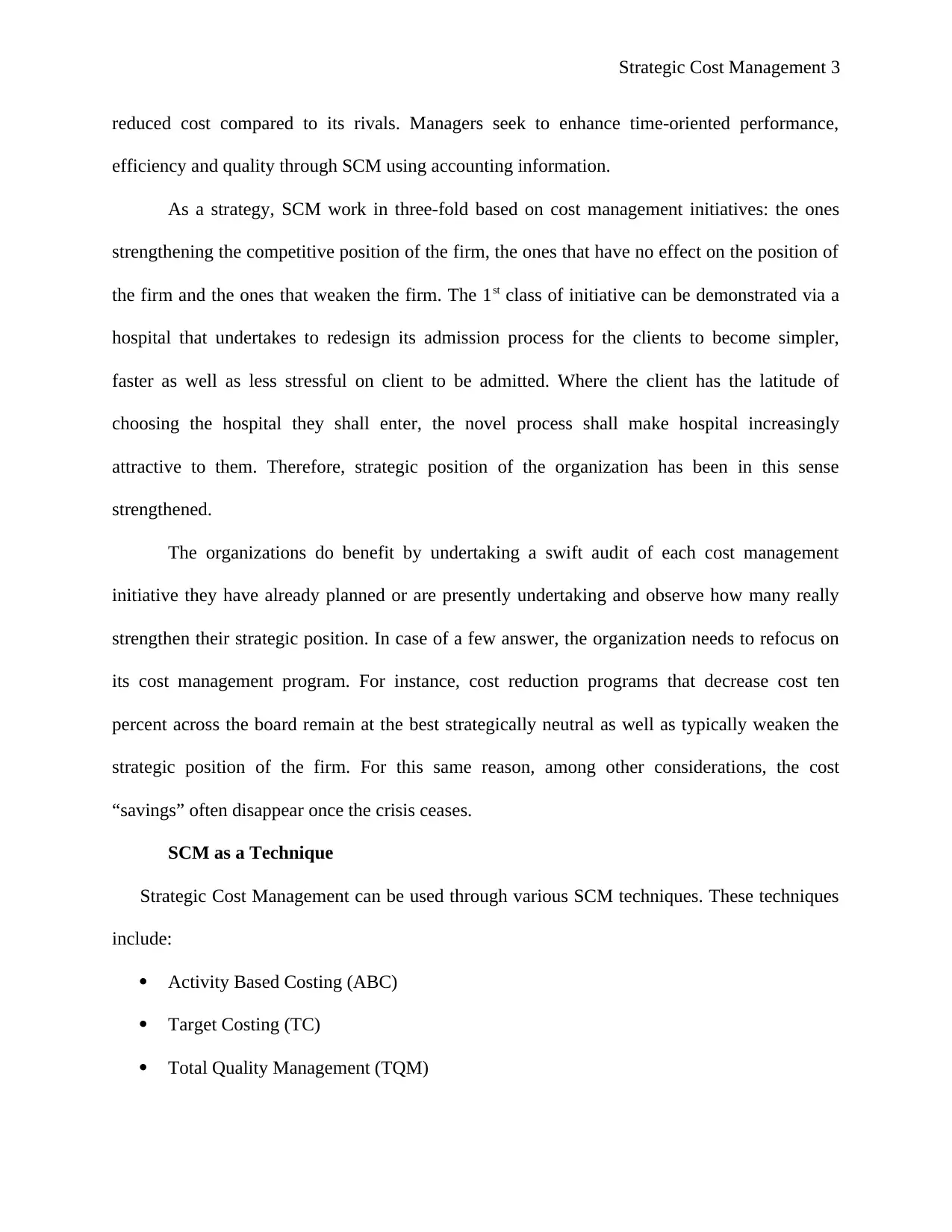
Strategic Cost Management 3
reduced cost compared to its rivals. Managers seek to enhance time-oriented performance,
efficiency and quality through SCM using accounting information.
As a strategy, SCM work in three-fold based on cost management initiatives: the ones
strengthening the competitive position of the firm, the ones that have no effect on the position of
the firm and the ones that weaken the firm. The 1st class of initiative can be demonstrated via a
hospital that undertakes to redesign its admission process for the clients to become simpler,
faster as well as less stressful on client to be admitted. Where the client has the latitude of
choosing the hospital they shall enter, the novel process shall make hospital increasingly
attractive to them. Therefore, strategic position of the organization has been in this sense
strengthened.
The organizations do benefit by undertaking a swift audit of each cost management
initiative they have already planned or are presently undertaking and observe how many really
strengthen their strategic position. In case of a few answer, the organization needs to refocus on
its cost management program. For instance, cost reduction programs that decrease cost ten
percent across the board remain at the best strategically neutral as well as typically weaken the
strategic position of the firm. For this same reason, among other considerations, the cost
“savings” often disappear once the crisis ceases.
SCM as a Technique
Strategic Cost Management can be used through various SCM techniques. These techniques
include:
Activity Based Costing (ABC)
Target Costing (TC)
Total Quality Management (TQM)
reduced cost compared to its rivals. Managers seek to enhance time-oriented performance,
efficiency and quality through SCM using accounting information.
As a strategy, SCM work in three-fold based on cost management initiatives: the ones
strengthening the competitive position of the firm, the ones that have no effect on the position of
the firm and the ones that weaken the firm. The 1st class of initiative can be demonstrated via a
hospital that undertakes to redesign its admission process for the clients to become simpler,
faster as well as less stressful on client to be admitted. Where the client has the latitude of
choosing the hospital they shall enter, the novel process shall make hospital increasingly
attractive to them. Therefore, strategic position of the organization has been in this sense
strengthened.
The organizations do benefit by undertaking a swift audit of each cost management
initiative they have already planned or are presently undertaking and observe how many really
strengthen their strategic position. In case of a few answer, the organization needs to refocus on
its cost management program. For instance, cost reduction programs that decrease cost ten
percent across the board remain at the best strategically neutral as well as typically weaken the
strategic position of the firm. For this same reason, among other considerations, the cost
“savings” often disappear once the crisis ceases.
SCM as a Technique
Strategic Cost Management can be used through various SCM techniques. These techniques
include:
Activity Based Costing (ABC)
Target Costing (TC)
Total Quality Management (TQM)
⊘ This is a preview!⊘
Do you want full access?
Subscribe today to unlock all pages.

Trusted by 1+ million students worldwide
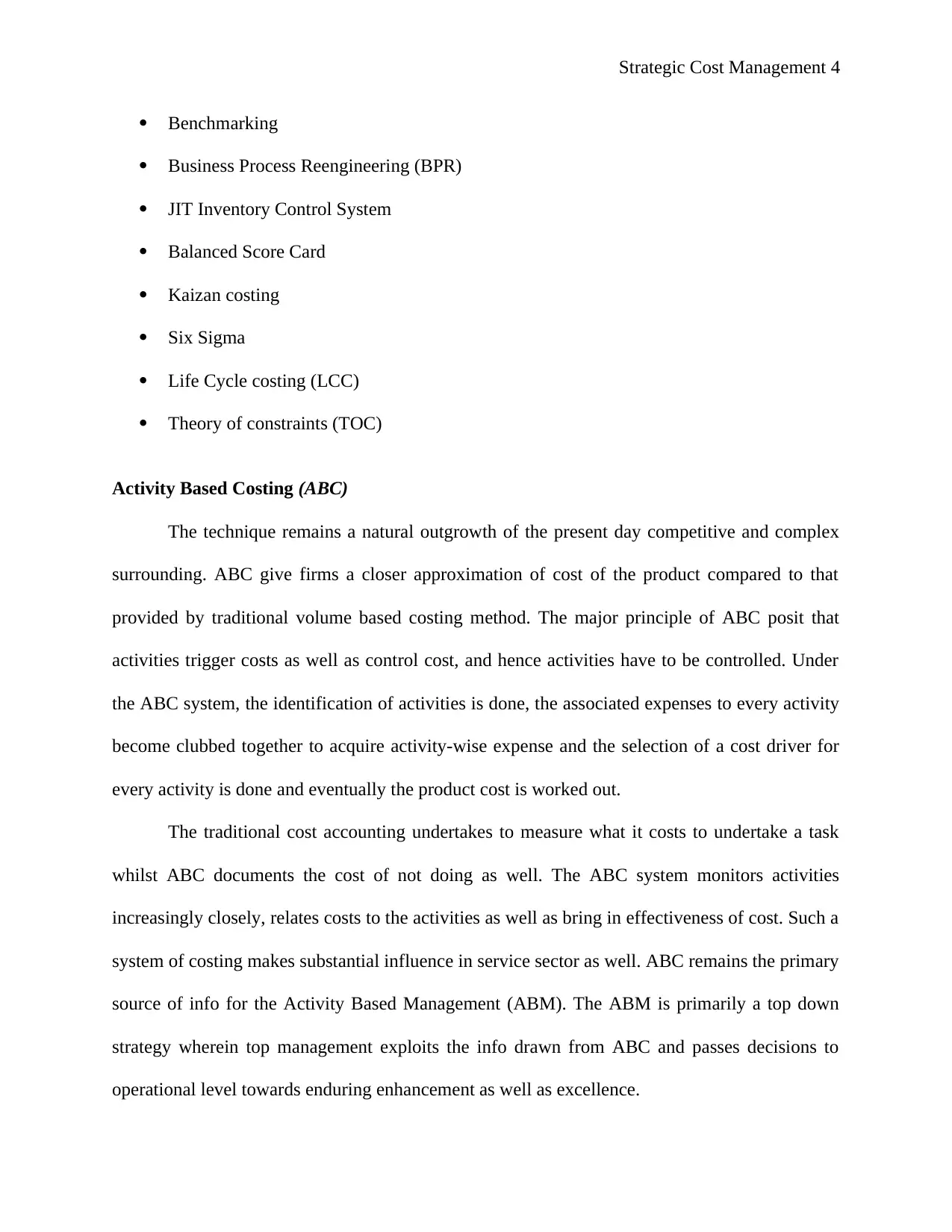
Strategic Cost Management 4
Benchmarking
Business Process Reengineering (BPR)
JIT Inventory Control System
Balanced Score Card
Kaizan costing
Six Sigma
Life Cycle costing (LCC)
Theory of constraints (TOC)
Activity Based Costing (ABC)
The technique remains a natural outgrowth of the present day competitive and complex
surrounding. ABC give firms a closer approximation of cost of the product compared to that
provided by traditional volume based costing method. The major principle of ABC posit that
activities trigger costs as well as control cost, and hence activities have to be controlled. Under
the ABC system, the identification of activities is done, the associated expenses to every activity
become clubbed together to acquire activity-wise expense and the selection of a cost driver for
every activity is done and eventually the product cost is worked out.
The traditional cost accounting undertakes to measure what it costs to undertake a task
whilst ABC documents the cost of not doing as well. The ABC system monitors activities
increasingly closely, relates costs to the activities as well as bring in effectiveness of cost. Such a
system of costing makes substantial influence in service sector as well. ABC remains the primary
source of info for the Activity Based Management (ABM). The ABM is primarily a top down
strategy wherein top management exploits the info drawn from ABC and passes decisions to
operational level towards enduring enhancement as well as excellence.
Benchmarking
Business Process Reengineering (BPR)
JIT Inventory Control System
Balanced Score Card
Kaizan costing
Six Sigma
Life Cycle costing (LCC)
Theory of constraints (TOC)
Activity Based Costing (ABC)
The technique remains a natural outgrowth of the present day competitive and complex
surrounding. ABC give firms a closer approximation of cost of the product compared to that
provided by traditional volume based costing method. The major principle of ABC posit that
activities trigger costs as well as control cost, and hence activities have to be controlled. Under
the ABC system, the identification of activities is done, the associated expenses to every activity
become clubbed together to acquire activity-wise expense and the selection of a cost driver for
every activity is done and eventually the product cost is worked out.
The traditional cost accounting undertakes to measure what it costs to undertake a task
whilst ABC documents the cost of not doing as well. The ABC system monitors activities
increasingly closely, relates costs to the activities as well as bring in effectiveness of cost. Such a
system of costing makes substantial influence in service sector as well. ABC remains the primary
source of info for the Activity Based Management (ABM). The ABM is primarily a top down
strategy wherein top management exploits the info drawn from ABC and passes decisions to
operational level towards enduring enhancement as well as excellence.
Paraphrase This Document
Need a fresh take? Get an instant paraphrase of this document with our AI Paraphraser
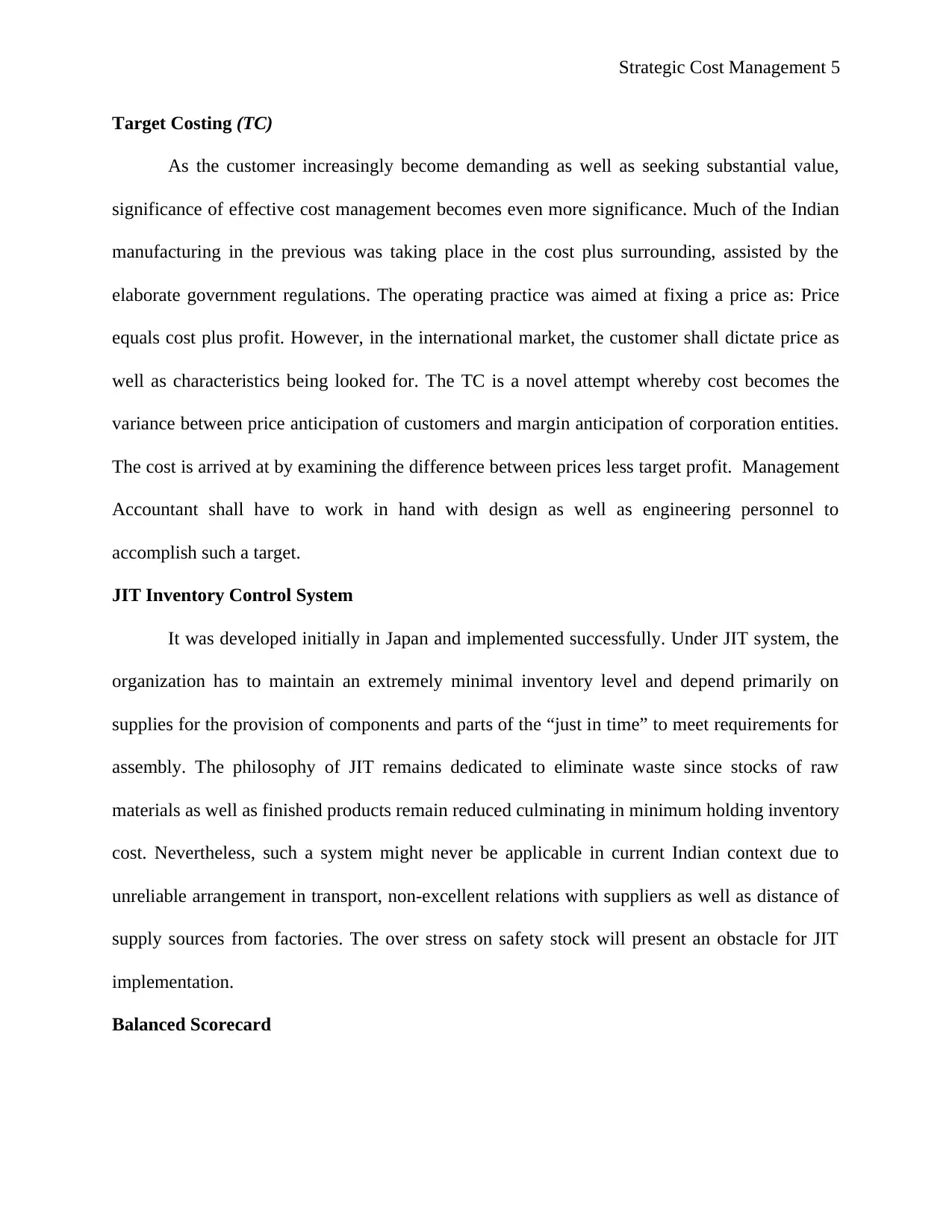
Strategic Cost Management 5
Target Costing (TC)
As the customer increasingly become demanding as well as seeking substantial value,
significance of effective cost management becomes even more significance. Much of the Indian
manufacturing in the previous was taking place in the cost plus surrounding, assisted by the
elaborate government regulations. The operating practice was aimed at fixing a price as: Price
equals cost plus profit. However, in the international market, the customer shall dictate price as
well as characteristics being looked for. The TC is a novel attempt whereby cost becomes the
variance between price anticipation of customers and margin anticipation of corporation entities.
The cost is arrived at by examining the difference between prices less target profit. Management
Accountant shall have to work in hand with design as well as engineering personnel to
accomplish such a target.
JIT Inventory Control System
It was developed initially in Japan and implemented successfully. Under JIT system, the
organization has to maintain an extremely minimal inventory level and depend primarily on
supplies for the provision of components and parts of the “just in time” to meet requirements for
assembly. The philosophy of JIT remains dedicated to eliminate waste since stocks of raw
materials as well as finished products remain reduced culminating in minimum holding inventory
cost. Nevertheless, such a system might never be applicable in current Indian context due to
unreliable arrangement in transport, non-excellent relations with suppliers as well as distance of
supply sources from factories. The over stress on safety stock will present an obstacle for JIT
implementation.
Balanced Scorecard
Target Costing (TC)
As the customer increasingly become demanding as well as seeking substantial value,
significance of effective cost management becomes even more significance. Much of the Indian
manufacturing in the previous was taking place in the cost plus surrounding, assisted by the
elaborate government regulations. The operating practice was aimed at fixing a price as: Price
equals cost plus profit. However, in the international market, the customer shall dictate price as
well as characteristics being looked for. The TC is a novel attempt whereby cost becomes the
variance between price anticipation of customers and margin anticipation of corporation entities.
The cost is arrived at by examining the difference between prices less target profit. Management
Accountant shall have to work in hand with design as well as engineering personnel to
accomplish such a target.
JIT Inventory Control System
It was developed initially in Japan and implemented successfully. Under JIT system, the
organization has to maintain an extremely minimal inventory level and depend primarily on
supplies for the provision of components and parts of the “just in time” to meet requirements for
assembly. The philosophy of JIT remains dedicated to eliminate waste since stocks of raw
materials as well as finished products remain reduced culminating in minimum holding inventory
cost. Nevertheless, such a system might never be applicable in current Indian context due to
unreliable arrangement in transport, non-excellent relations with suppliers as well as distance of
supply sources from factories. The over stress on safety stock will present an obstacle for JIT
implementation.
Balanced Scorecard
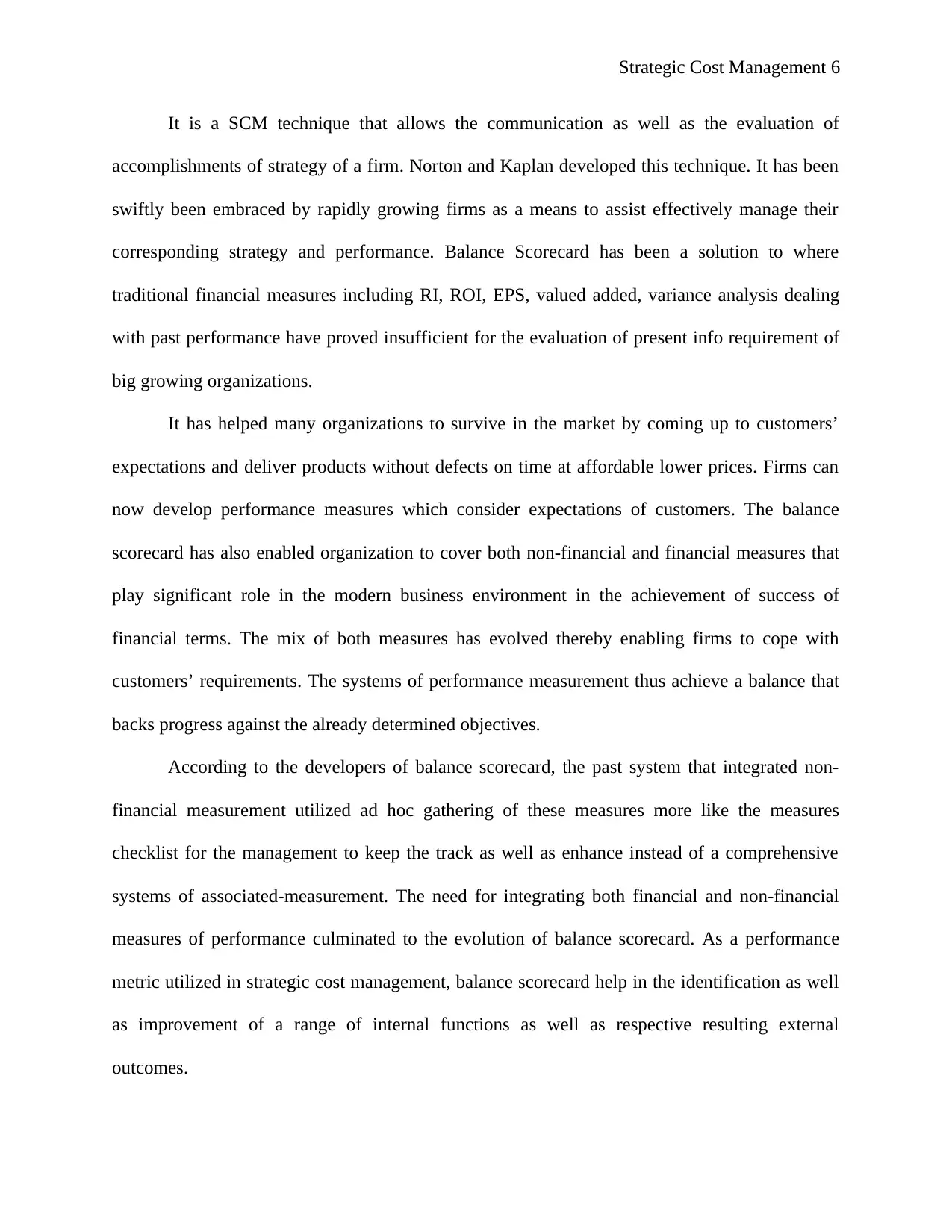
Strategic Cost Management 6
It is a SCM technique that allows the communication as well as the evaluation of
accomplishments of strategy of a firm. Norton and Kaplan developed this technique. It has been
swiftly been embraced by rapidly growing firms as a means to assist effectively manage their
corresponding strategy and performance. Balance Scorecard has been a solution to where
traditional financial measures including RI, ROI, EPS, valued added, variance analysis dealing
with past performance have proved insufficient for the evaluation of present info requirement of
big growing organizations.
It has helped many organizations to survive in the market by coming up to customers’
expectations and deliver products without defects on time at affordable lower prices. Firms can
now develop performance measures which consider expectations of customers. The balance
scorecard has also enabled organization to cover both non-financial and financial measures that
play significant role in the modern business environment in the achievement of success of
financial terms. The mix of both measures has evolved thereby enabling firms to cope with
customers’ requirements. The systems of performance measurement thus achieve a balance that
backs progress against the already determined objectives.
According to the developers of balance scorecard, the past system that integrated non-
financial measurement utilized ad hoc gathering of these measures more like the measures
checklist for the management to keep the track as well as enhance instead of a comprehensive
systems of associated-measurement. The need for integrating both financial and non-financial
measures of performance culminated to the evolution of balance scorecard. As a performance
metric utilized in strategic cost management, balance scorecard help in the identification as well
as improvement of a range of internal functions as well as respective resulting external
outcomes.
It is a SCM technique that allows the communication as well as the evaluation of
accomplishments of strategy of a firm. Norton and Kaplan developed this technique. It has been
swiftly been embraced by rapidly growing firms as a means to assist effectively manage their
corresponding strategy and performance. Balance Scorecard has been a solution to where
traditional financial measures including RI, ROI, EPS, valued added, variance analysis dealing
with past performance have proved insufficient for the evaluation of present info requirement of
big growing organizations.
It has helped many organizations to survive in the market by coming up to customers’
expectations and deliver products without defects on time at affordable lower prices. Firms can
now develop performance measures which consider expectations of customers. The balance
scorecard has also enabled organization to cover both non-financial and financial measures that
play significant role in the modern business environment in the achievement of success of
financial terms. The mix of both measures has evolved thereby enabling firms to cope with
customers’ requirements. The systems of performance measurement thus achieve a balance that
backs progress against the already determined objectives.
According to the developers of balance scorecard, the past system that integrated non-
financial measurement utilized ad hoc gathering of these measures more like the measures
checklist for the management to keep the track as well as enhance instead of a comprehensive
systems of associated-measurement. The need for integrating both financial and non-financial
measures of performance culminated to the evolution of balance scorecard. As a performance
metric utilized in strategic cost management, balance scorecard help in the identification as well
as improvement of a range of internal functions as well as respective resulting external
outcomes.
⊘ This is a preview!⊘
Do you want full access?
Subscribe today to unlock all pages.

Trusted by 1+ million students worldwide
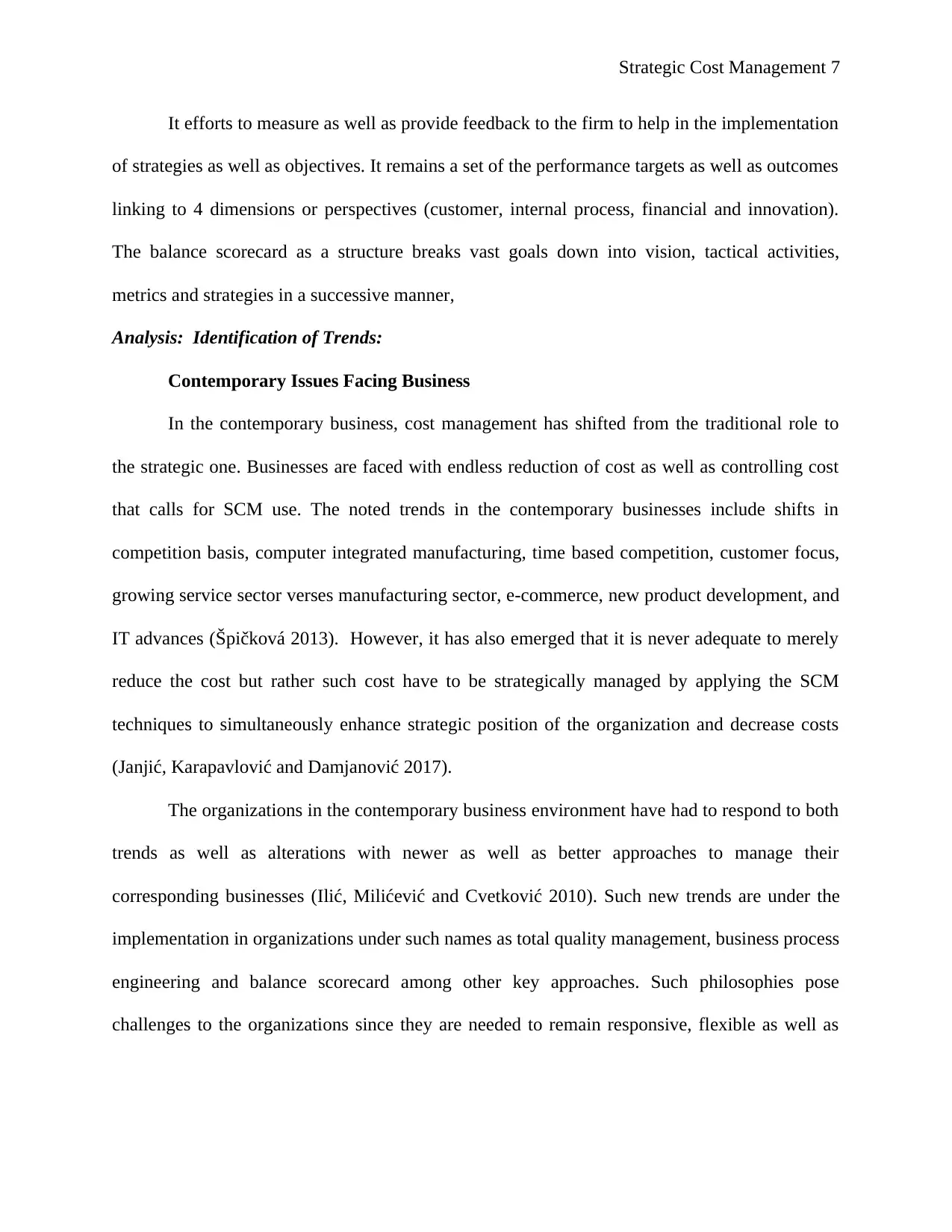
Strategic Cost Management 7
It efforts to measure as well as provide feedback to the firm to help in the implementation
of strategies as well as objectives. It remains a set of the performance targets as well as outcomes
linking to 4 dimensions or perspectives (customer, internal process, financial and innovation).
The balance scorecard as a structure breaks vast goals down into vision, tactical activities,
metrics and strategies in a successive manner,
Analysis: Identification of Trends:
Contemporary Issues Facing Business
In the contemporary business, cost management has shifted from the traditional role to
the strategic one. Businesses are faced with endless reduction of cost as well as controlling cost
that calls for SCM use. The noted trends in the contemporary businesses include shifts in
competition basis, computer integrated manufacturing, time based competition, customer focus,
growing service sector verses manufacturing sector, e-commerce, new product development, and
IT advances (Špičková 2013). However, it has also emerged that it is never adequate to merely
reduce the cost but rather such cost have to be strategically managed by applying the SCM
techniques to simultaneously enhance strategic position of the organization and decrease costs
(Janjić, Karapavlović and Damjanović 2017).
The organizations in the contemporary business environment have had to respond to both
trends as well as alterations with newer as well as better approaches to manage their
corresponding businesses (Ilić, Milićević and Cvetković 2010). Such new trends are under the
implementation in organizations under such names as total quality management, business process
engineering and balance scorecard among other key approaches. Such philosophies pose
challenges to the organizations since they are needed to remain responsive, flexible as well as
It efforts to measure as well as provide feedback to the firm to help in the implementation
of strategies as well as objectives. It remains a set of the performance targets as well as outcomes
linking to 4 dimensions or perspectives (customer, internal process, financial and innovation).
The balance scorecard as a structure breaks vast goals down into vision, tactical activities,
metrics and strategies in a successive manner,
Analysis: Identification of Trends:
Contemporary Issues Facing Business
In the contemporary business, cost management has shifted from the traditional role to
the strategic one. Businesses are faced with endless reduction of cost as well as controlling cost
that calls for SCM use. The noted trends in the contemporary businesses include shifts in
competition basis, computer integrated manufacturing, time based competition, customer focus,
growing service sector verses manufacturing sector, e-commerce, new product development, and
IT advances (Špičková 2013). However, it has also emerged that it is never adequate to merely
reduce the cost but rather such cost have to be strategically managed by applying the SCM
techniques to simultaneously enhance strategic position of the organization and decrease costs
(Janjić, Karapavlović and Damjanović 2017).
The organizations in the contemporary business environment have had to respond to both
trends as well as alterations with newer as well as better approaches to manage their
corresponding businesses (Ilić, Milićević and Cvetković 2010). Such new trends are under the
implementation in organizations under such names as total quality management, business process
engineering and balance scorecard among other key approaches. Such philosophies pose
challenges to the organizations since they are needed to remain responsive, flexible as well as
Paraphrase This Document
Need a fresh take? Get an instant paraphrase of this document with our AI Paraphraser
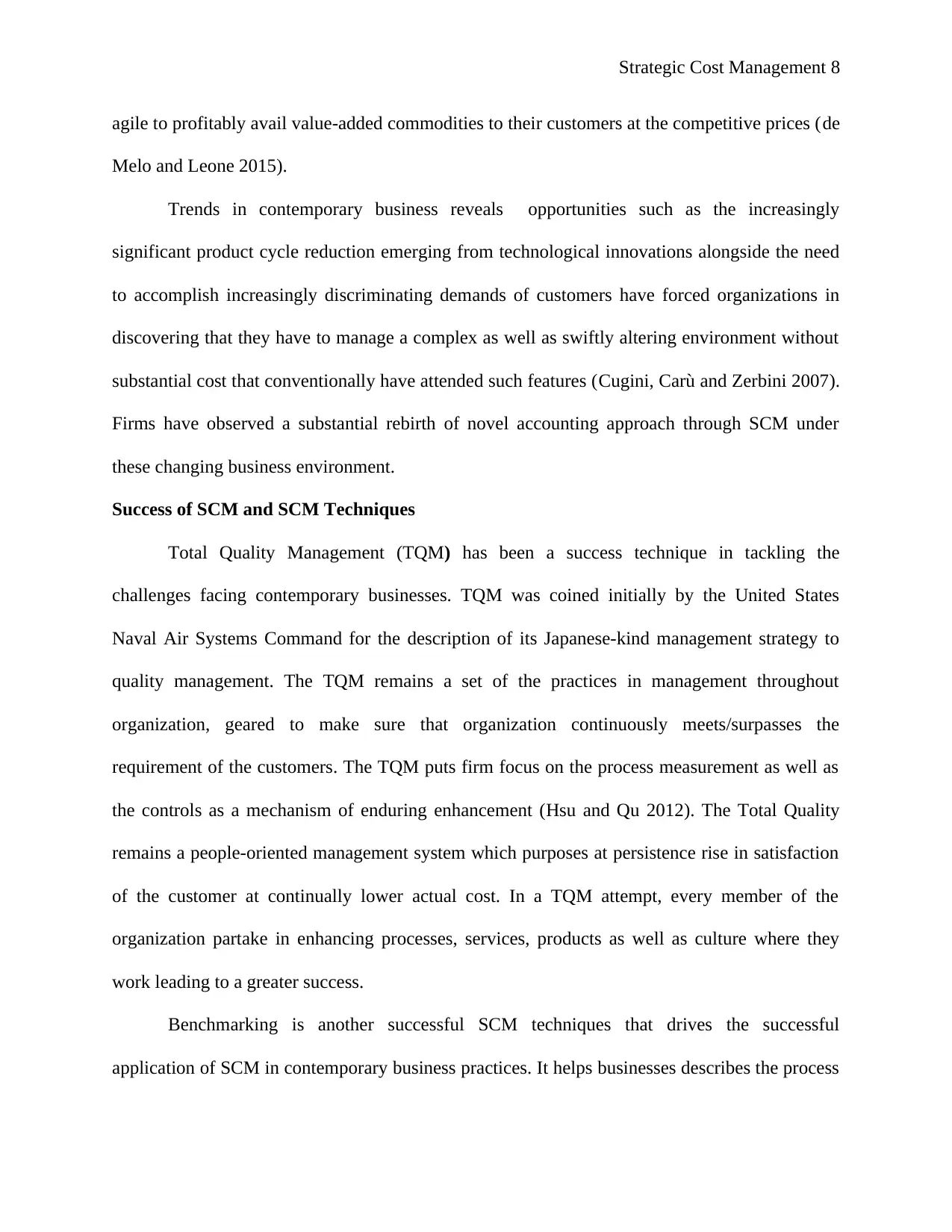
Strategic Cost Management 8
agile to profitably avail value-added commodities to their customers at the competitive prices (de
Melo and Leone 2015).
Trends in contemporary business reveals opportunities such as the increasingly
significant product cycle reduction emerging from technological innovations alongside the need
to accomplish increasingly discriminating demands of customers have forced organizations in
discovering that they have to manage a complex as well as swiftly altering environment without
substantial cost that conventionally have attended such features (Cugini, Carù and Zerbini 2007).
Firms have observed a substantial rebirth of novel accounting approach through SCM under
these changing business environment.
Success of SCM and SCM Techniques
Total Quality Management (TQM) has been a success technique in tackling the
challenges facing contemporary businesses. TQM was coined initially by the United States
Naval Air Systems Command for the description of its Japanese-kind management strategy to
quality management. The TQM remains a set of the practices in management throughout
organization, geared to make sure that organization continuously meets/surpasses the
requirement of the customers. The TQM puts firm focus on the process measurement as well as
the controls as a mechanism of enduring enhancement (Hsu and Qu 2012). The Total Quality
remains a people-oriented management system which purposes at persistence rise in satisfaction
of the customer at continually lower actual cost. In a TQM attempt, every member of the
organization partake in enhancing processes, services, products as well as culture where they
work leading to a greater success.
Benchmarking is another successful SCM techniques that drives the successful
application of SCM in contemporary business practices. It helps businesses describes the process
agile to profitably avail value-added commodities to their customers at the competitive prices (de
Melo and Leone 2015).
Trends in contemporary business reveals opportunities such as the increasingly
significant product cycle reduction emerging from technological innovations alongside the need
to accomplish increasingly discriminating demands of customers have forced organizations in
discovering that they have to manage a complex as well as swiftly altering environment without
substantial cost that conventionally have attended such features (Cugini, Carù and Zerbini 2007).
Firms have observed a substantial rebirth of novel accounting approach through SCM under
these changing business environment.
Success of SCM and SCM Techniques
Total Quality Management (TQM) has been a success technique in tackling the
challenges facing contemporary businesses. TQM was coined initially by the United States
Naval Air Systems Command for the description of its Japanese-kind management strategy to
quality management. The TQM remains a set of the practices in management throughout
organization, geared to make sure that organization continuously meets/surpasses the
requirement of the customers. The TQM puts firm focus on the process measurement as well as
the controls as a mechanism of enduring enhancement (Hsu and Qu 2012). The Total Quality
remains a people-oriented management system which purposes at persistence rise in satisfaction
of the customer at continually lower actual cost. In a TQM attempt, every member of the
organization partake in enhancing processes, services, products as well as culture where they
work leading to a greater success.
Benchmarking is another successful SCM techniques that drives the successful
application of SCM in contemporary business practices. It helps businesses describes the process
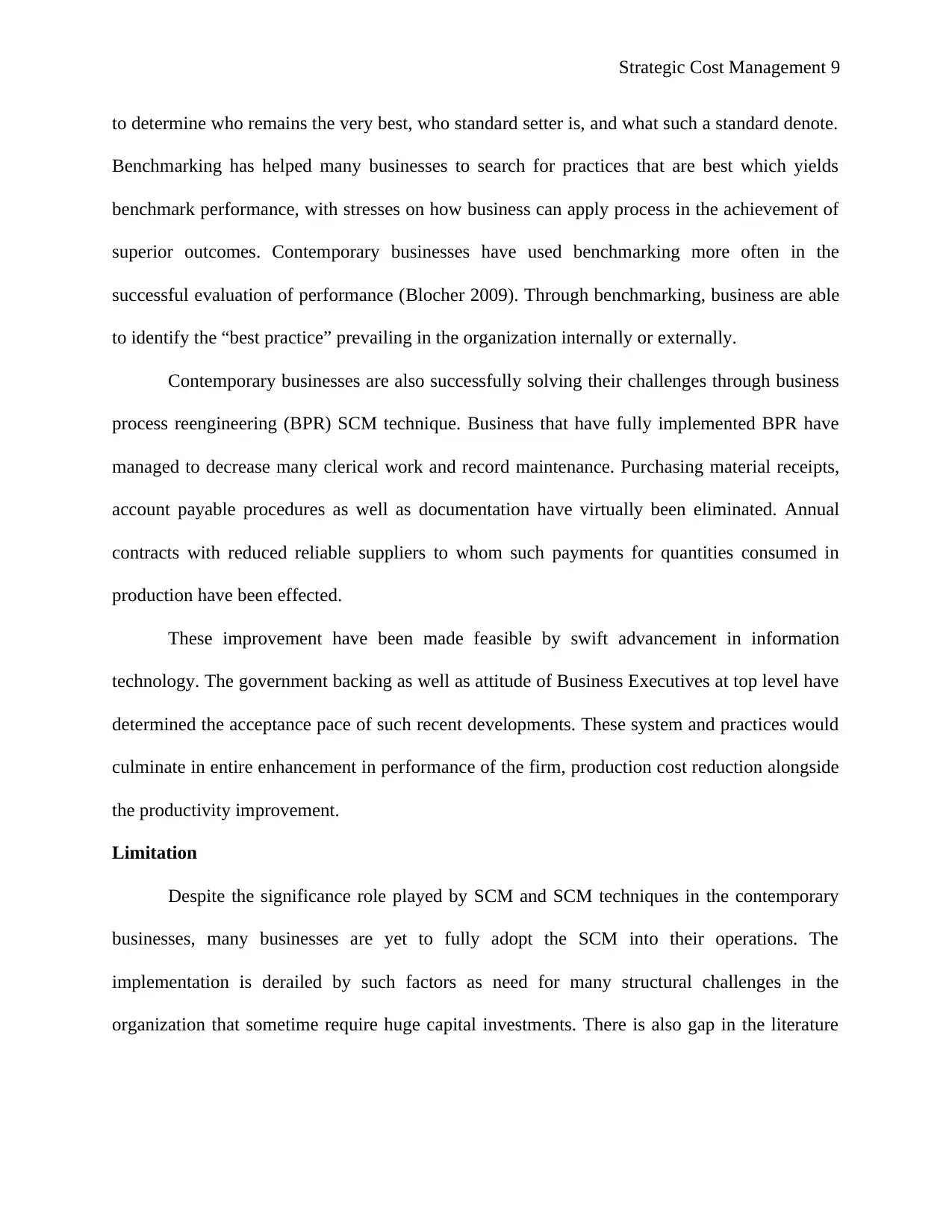
Strategic Cost Management 9
to determine who remains the very best, who standard setter is, and what such a standard denote.
Benchmarking has helped many businesses to search for practices that are best which yields
benchmark performance, with stresses on how business can apply process in the achievement of
superior outcomes. Contemporary businesses have used benchmarking more often in the
successful evaluation of performance (Blocher 2009). Through benchmarking, business are able
to identify the “best practice” prevailing in the organization internally or externally.
Contemporary businesses are also successfully solving their challenges through business
process reengineering (BPR) SCM technique. Business that have fully implemented BPR have
managed to decrease many clerical work and record maintenance. Purchasing material receipts,
account payable procedures as well as documentation have virtually been eliminated. Annual
contracts with reduced reliable suppliers to whom such payments for quantities consumed in
production have been effected.
These improvement have been made feasible by swift advancement in information
technology. The government backing as well as attitude of Business Executives at top level have
determined the acceptance pace of such recent developments. These system and practices would
culminate in entire enhancement in performance of the firm, production cost reduction alongside
the productivity improvement.
Limitation
Despite the significance role played by SCM and SCM techniques in the contemporary
businesses, many businesses are yet to fully adopt the SCM into their operations. The
implementation is derailed by such factors as need for many structural challenges in the
organization that sometime require huge capital investments. There is also gap in the literature
to determine who remains the very best, who standard setter is, and what such a standard denote.
Benchmarking has helped many businesses to search for practices that are best which yields
benchmark performance, with stresses on how business can apply process in the achievement of
superior outcomes. Contemporary businesses have used benchmarking more often in the
successful evaluation of performance (Blocher 2009). Through benchmarking, business are able
to identify the “best practice” prevailing in the organization internally or externally.
Contemporary businesses are also successfully solving their challenges through business
process reengineering (BPR) SCM technique. Business that have fully implemented BPR have
managed to decrease many clerical work and record maintenance. Purchasing material receipts,
account payable procedures as well as documentation have virtually been eliminated. Annual
contracts with reduced reliable suppliers to whom such payments for quantities consumed in
production have been effected.
These improvement have been made feasible by swift advancement in information
technology. The government backing as well as attitude of Business Executives at top level have
determined the acceptance pace of such recent developments. These system and practices would
culminate in entire enhancement in performance of the firm, production cost reduction alongside
the productivity improvement.
Limitation
Despite the significance role played by SCM and SCM techniques in the contemporary
businesses, many businesses are yet to fully adopt the SCM into their operations. The
implementation is derailed by such factors as need for many structural challenges in the
organization that sometime require huge capital investments. There is also gap in the literature
⊘ This is a preview!⊘
Do you want full access?
Subscribe today to unlock all pages.

Trusted by 1+ million students worldwide
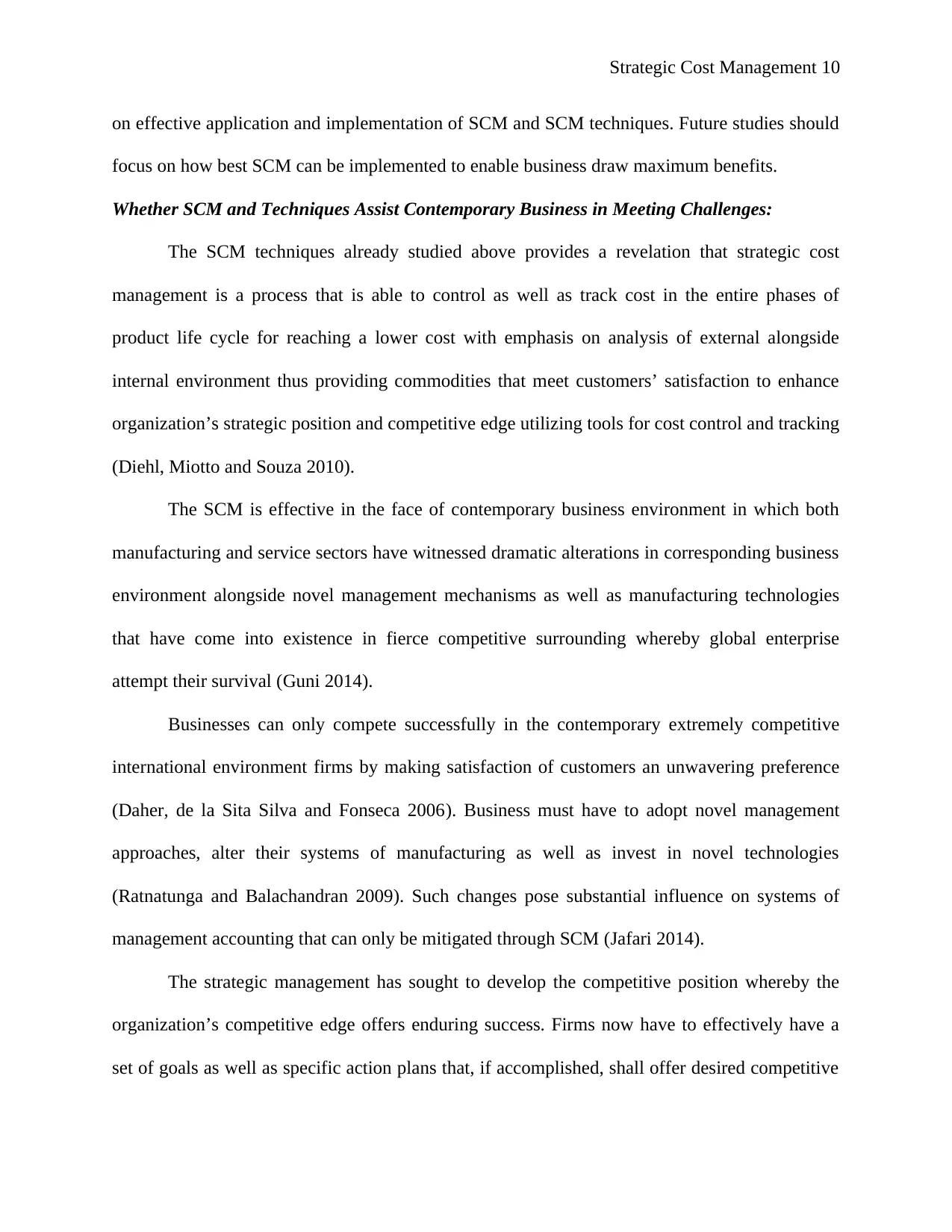
Strategic Cost Management 10
on effective application and implementation of SCM and SCM techniques. Future studies should
focus on how best SCM can be implemented to enable business draw maximum benefits.
Whether SCM and Techniques Assist Contemporary Business in Meeting Challenges:
The SCM techniques already studied above provides a revelation that strategic cost
management is a process that is able to control as well as track cost in the entire phases of
product life cycle for reaching a lower cost with emphasis on analysis of external alongside
internal environment thus providing commodities that meet customers’ satisfaction to enhance
organization’s strategic position and competitive edge utilizing tools for cost control and tracking
(Diehl, Miotto and Souza 2010).
The SCM is effective in the face of contemporary business environment in which both
manufacturing and service sectors have witnessed dramatic alterations in corresponding business
environment alongside novel management mechanisms as well as manufacturing technologies
that have come into existence in fierce competitive surrounding whereby global enterprise
attempt their survival (Guni 2014).
Businesses can only compete successfully in the contemporary extremely competitive
international environment firms by making satisfaction of customers an unwavering preference
(Daher, de la Sita Silva and Fonseca 2006). Business must have to adopt novel management
approaches, alter their systems of manufacturing as well as invest in novel technologies
(Ratnatunga and Balachandran 2009). Such changes pose substantial influence on systems of
management accounting that can only be mitigated through SCM (Jafari 2014).
The strategic management has sought to develop the competitive position whereby the
organization’s competitive edge offers enduring success. Firms now have to effectively have a
set of goals as well as specific action plans that, if accomplished, shall offer desired competitive
on effective application and implementation of SCM and SCM techniques. Future studies should
focus on how best SCM can be implemented to enable business draw maximum benefits.
Whether SCM and Techniques Assist Contemporary Business in Meeting Challenges:
The SCM techniques already studied above provides a revelation that strategic cost
management is a process that is able to control as well as track cost in the entire phases of
product life cycle for reaching a lower cost with emphasis on analysis of external alongside
internal environment thus providing commodities that meet customers’ satisfaction to enhance
organization’s strategic position and competitive edge utilizing tools for cost control and tracking
(Diehl, Miotto and Souza 2010).
The SCM is effective in the face of contemporary business environment in which both
manufacturing and service sectors have witnessed dramatic alterations in corresponding business
environment alongside novel management mechanisms as well as manufacturing technologies
that have come into existence in fierce competitive surrounding whereby global enterprise
attempt their survival (Guni 2014).
Businesses can only compete successfully in the contemporary extremely competitive
international environment firms by making satisfaction of customers an unwavering preference
(Daher, de la Sita Silva and Fonseca 2006). Business must have to adopt novel management
approaches, alter their systems of manufacturing as well as invest in novel technologies
(Ratnatunga and Balachandran 2009). Such changes pose substantial influence on systems of
management accounting that can only be mitigated through SCM (Jafari 2014).
The strategic management has sought to develop the competitive position whereby the
organization’s competitive edge offers enduring success. Firms now have to effectively have a
set of goals as well as specific action plans that, if accomplished, shall offer desired competitive
Paraphrase This Document
Need a fresh take? Get an instant paraphrase of this document with our AI Paraphraser
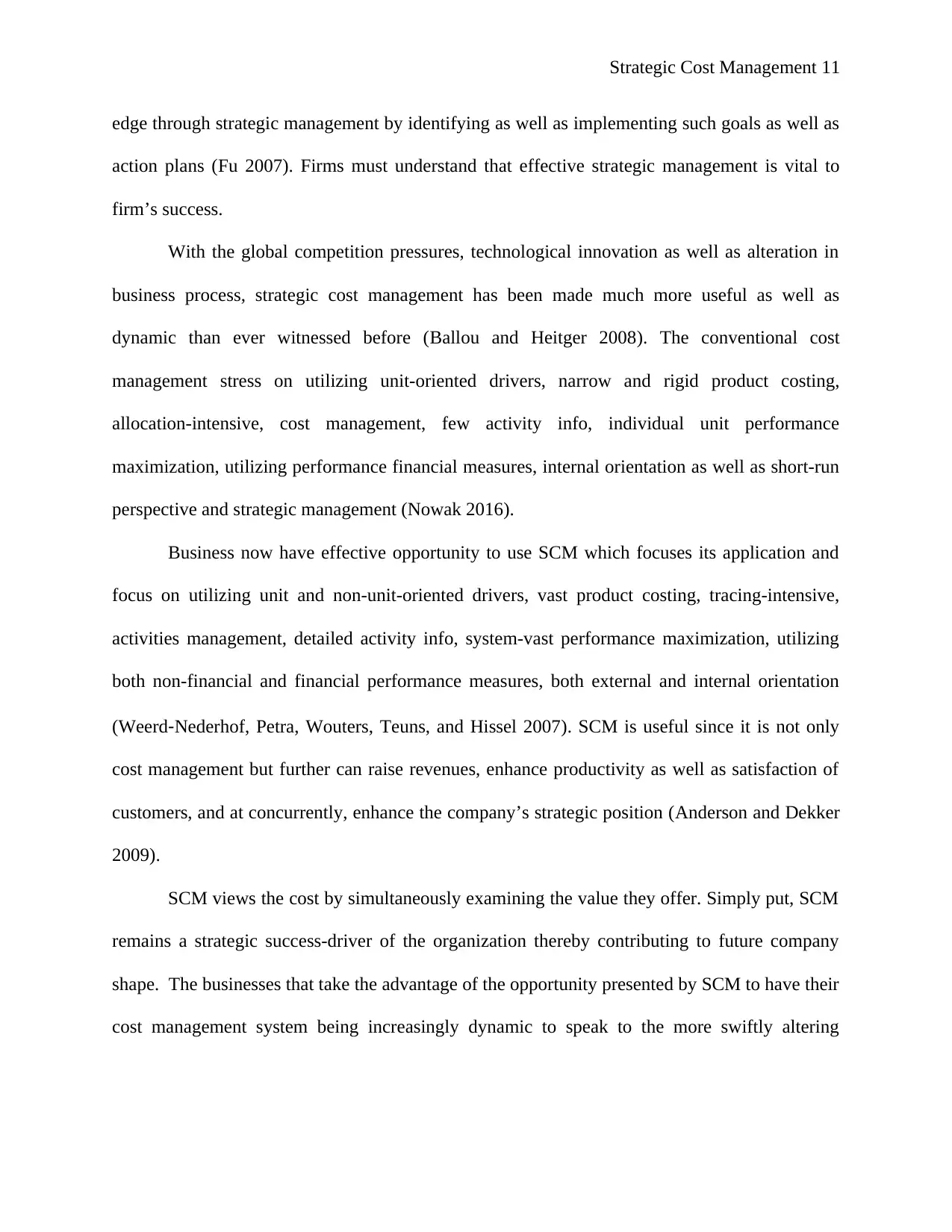
Strategic Cost Management 11
edge through strategic management by identifying as well as implementing such goals as well as
action plans (Fu 2007). Firms must understand that effective strategic management is vital to
firm’s success.
With the global competition pressures, technological innovation as well as alteration in
business process, strategic cost management has been made much more useful as well as
dynamic than ever witnessed before (Ballou and Heitger 2008). The conventional cost
management stress on utilizing unit-oriented drivers, narrow and rigid product costing,
allocation-intensive, cost management, few activity info, individual unit performance
maximization, utilizing performance financial measures, internal orientation as well as short-run
perspective and strategic management (Nowak 2016).
Business now have effective opportunity to use SCM which focuses its application and
focus on utilizing unit and non-unit-oriented drivers, vast product costing, tracing-intensive,
activities management, detailed activity info, system-vast performance maximization, utilizing
both non-financial and financial performance measures, both external and internal orientation
(Weerd‐Nederhof, Petra, Wouters, Teuns, and Hissel 2007). SCM is useful since it is not only
cost management but further can raise revenues, enhance productivity as well as satisfaction of
customers, and at concurrently, enhance the company’s strategic position (Anderson and Dekker
2009).
SCM views the cost by simultaneously examining the value they offer. Simply put, SCM
remains a strategic success-driver of the organization thereby contributing to future company
shape. The businesses that take the advantage of the opportunity presented by SCM to have their
cost management system being increasingly dynamic to speak to the more swiftly altering
edge through strategic management by identifying as well as implementing such goals as well as
action plans (Fu 2007). Firms must understand that effective strategic management is vital to
firm’s success.
With the global competition pressures, technological innovation as well as alteration in
business process, strategic cost management has been made much more useful as well as
dynamic than ever witnessed before (Ballou and Heitger 2008). The conventional cost
management stress on utilizing unit-oriented drivers, narrow and rigid product costing,
allocation-intensive, cost management, few activity info, individual unit performance
maximization, utilizing performance financial measures, internal orientation as well as short-run
perspective and strategic management (Nowak 2016).
Business now have effective opportunity to use SCM which focuses its application and
focus on utilizing unit and non-unit-oriented drivers, vast product costing, tracing-intensive,
activities management, detailed activity info, system-vast performance maximization, utilizing
both non-financial and financial performance measures, both external and internal orientation
(Weerd‐Nederhof, Petra, Wouters, Teuns, and Hissel 2007). SCM is useful since it is not only
cost management but further can raise revenues, enhance productivity as well as satisfaction of
customers, and at concurrently, enhance the company’s strategic position (Anderson and Dekker
2009).
SCM views the cost by simultaneously examining the value they offer. Simply put, SCM
remains a strategic success-driver of the organization thereby contributing to future company
shape. The businesses that take the advantage of the opportunity presented by SCM to have their
cost management system being increasingly dynamic to speak to the more swiftly altering
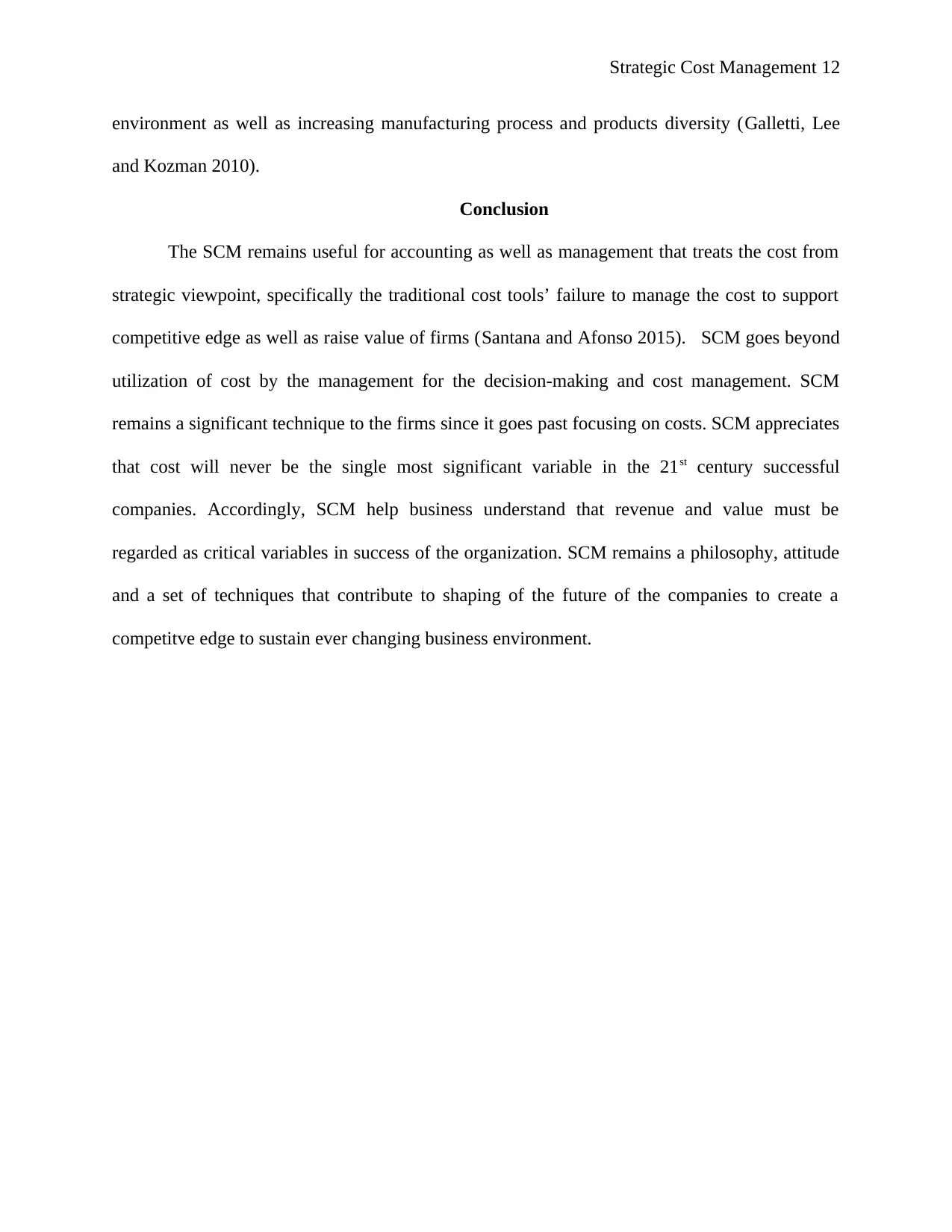
Strategic Cost Management 12
environment as well as increasing manufacturing process and products diversity (Galletti, Lee
and Kozman 2010).
Conclusion
The SCM remains useful for accounting as well as management that treats the cost from
strategic viewpoint, specifically the traditional cost tools’ failure to manage the cost to support
competitive edge as well as raise value of firms (Santana and Afonso 2015). SCM goes beyond
utilization of cost by the management for the decision-making and cost management. SCM
remains a significant technique to the firms since it goes past focusing on costs. SCM appreciates
that cost will never be the single most significant variable in the 21st century successful
companies. Accordingly, SCM help business understand that revenue and value must be
regarded as critical variables in success of the organization. SCM remains a philosophy, attitude
and a set of techniques that contribute to shaping of the future of the companies to create a
competitve edge to sustain ever changing business environment.
environment as well as increasing manufacturing process and products diversity (Galletti, Lee
and Kozman 2010).
Conclusion
The SCM remains useful for accounting as well as management that treats the cost from
strategic viewpoint, specifically the traditional cost tools’ failure to manage the cost to support
competitive edge as well as raise value of firms (Santana and Afonso 2015). SCM goes beyond
utilization of cost by the management for the decision-making and cost management. SCM
remains a significant technique to the firms since it goes past focusing on costs. SCM appreciates
that cost will never be the single most significant variable in the 21st century successful
companies. Accordingly, SCM help business understand that revenue and value must be
regarded as critical variables in success of the organization. SCM remains a philosophy, attitude
and a set of techniques that contribute to shaping of the future of the companies to create a
competitve edge to sustain ever changing business environment.
⊘ This is a preview!⊘
Do you want full access?
Subscribe today to unlock all pages.

Trusted by 1+ million students worldwide
1 out of 15
Related Documents
Your All-in-One AI-Powered Toolkit for Academic Success.
+13062052269
info@desklib.com
Available 24*7 on WhatsApp / Email
![[object Object]](/_next/static/media/star-bottom.7253800d.svg)
Unlock your academic potential
Copyright © 2020–2025 A2Z Services. All Rights Reserved. Developed and managed by ZUCOL.




